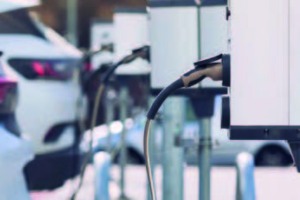Back to Basics of EV Charging

What is an EV Charge Point?
At its simplest, an electric vehicle charging point is a piece of interface equipment that connects a single electric vehicle to an electricity supply, allowing the vehicle’s battery to be charged. This battery provides the power to propel the vehicle, which can be fully electric or a plug-in hybrid90. The term ‘charge point’ is often used interchangeably with ‘charging point’.
Charging points can be stand-alone interfaces (as is the case with most home charge points) or can be arranged in various combinations or clusters at particular locations. These combined charging points form hubs where more than one electric vehicle can charge at a time.
Most publicly-accessible EV charging points consist of a single parking bay and an adjacent electricity connection point. Where more than one charging point is provided, multiple connection points can be grouped together in single charging stations. This reduces the cabling and hardware required to connect the charge point to the electricity supply and is an efficient way of allowing more than one vehicle to charge at a time. A common arrangement is to have two twinned sockets set in a single charging station, serving two side-by-side or back-to-back parking bays.
When EV technologies were at an early stage, different manufacturers developed different types of connection points and sockets. This meant that vehicle owners had limited options when it came to where and how they could charge their EVs. As the EV market has developed, standard, interoperable connection points have become more common, particularly in the EU.
With more standardised connection points and charge point sockets, EV charging is now mainly differentiated by power and vehicle battery capacity. Another key factor is whether the electricity supplied to the charge point can be drawn from conventional domestic supply arrangements, or whether a higher connective capacity is required.
How Does EV Charging Work?
To charge an EV, the vehicle is parked and attached to the charging point connection or socket by a charge point cable. EV charge points generally fall into two categories: standard charging and fast charging, otherwise known as AC and DC charging.
Alternating Current (AC)
AC charging is associated with slower speeds of EV charging. There are two types of AC charging: single phase and three phase. When charging, AC electricity is supplied by the charge point to the vehicle. The onboard charger on the vehicle detects the maximum power available from the charge point. The vehicle converts this AC power into DC power and manages the charging of each cell in the vehicle’s battery pack.
Direct Current (DC)
DC charging is largely associated with faster speeds of charging. DC charging can quickly charge the battery pack of the vehicle. In this case, the DC charge point converts AC electricity into DC electricity which it supplies to the vehicle. This is channelled directly to the battery. The process is controlled and managed via the vehicle’s battery management system. This communicates with the DC charger via the connecting cable and tells the charger how much power to supply at any given point during the process. It also controls the start and stop of the charging process.
The power level (in kW) of a charge point indicates the maximum amount of energy which could be supplied to a battery pack over the course of one hour. The actual amount of energy transferred to the battery will depend on factors such as the battery’s internal resistance, the maximum rate that the pack can sustain at the given charge level on commencement of charge, the battery cooling system, etc. Also, with top-up charging (particularly when using higher-powered fast charge points), EV users often do not need to fully charge their EVs. Instead, they can plug in and charge the battery just enough to get them to their destinations.
AC electricity can be used by all speeds of charge points, while DC electricity can only be used by fast or high-powered charge points. In most residential areas, single-phase AC electrical power supplies are most common, as this type of supply system is suited to relatively low electrical loads (such as lighting and heating), with a few large electric motors. For larger industrial or commercial buildings, a higher-power three-phase AC system is often used. The type of available AC supply determines the type of charge point that can be installed, as charge points that supply electricity significantly above 7 kW (such as 11 kW to 22 kW) generally require a three-phase AC supply.
Additionally, most electric cars currently on the market are either unable to accommodate more than c. 7 kW on a single-phase AC supply, or (if they can take higher AC charges of up to 11 kW) have been designed so that if a single-phase AC electricity supply is involved, they will not charge above 7 kW. This means that in residential areas, the most effective types of charge points are the lower wattage 7 kW-11 kW charge points that work best over longer charging timeframes, such as overnight. AC charge points also tend to be more compact in size, meaning that they fit better in domestic contexts where space for charging infrastructure may be limited.
Types of Connectors
EVs also have different types of connectors for different speeds of charge and can only be plugged in to charge points with the same type of connector unless an adaptor is used.
Type 2 connectors: For AC charging (standard/ fast), European EVs typically use a Type 2 connector. Type 2 connector technologies are more common in newer EVs, and the use of this charge point type has been supported as a way to achieve standardised, interoperable charging across the EU.
Combined Charging Standard (CCS) or CHAdeMO connector types: Some charging stations contain more than one connector type (e.g. both CCS and CHAdeMO), allowing the charging of a range of different EV models. In practice, this means that most EVs will be able to use most publicly accessible charge points.


